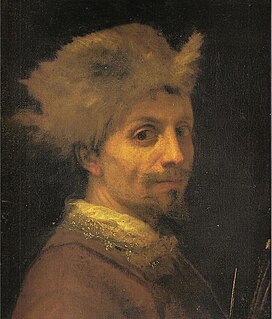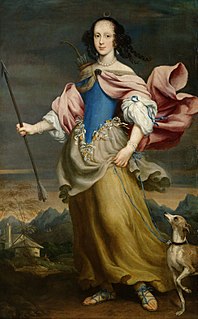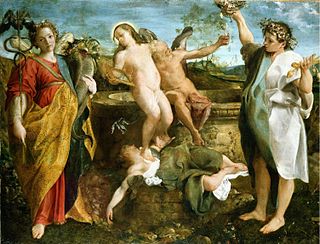
Sigismondo Coccapani (1585 - 1643) was an Italian painter of the Baroque period. Born in Florence, he studied under Ludovico Cigoli in Rome, before returning to his native city.

Sigismondo Coccapani (1585 - 1643) was an Italian painter of the Baroque period. Born in Florence, he studied under Ludovico Cigoli in Rome, before returning to his native city.
Coccapani was born at Florence in 1585. He at first studied literature and mathematics, but abandoned them for painting, [1] becoming a pupil of Ludovico Cigoli in Rome [2] where he assisted him on his work at Santa Maria Maggiore in 1610–13. [3] Using his scientific background he showed Cigoli, who was making a record of solar activity for his friend Galileo, how to observe and record sunspots through a method of projection. [4] Coccapani also studied architecture with Bernardo Buontalenti. Most of his work as an independent artist was done in Florence, where he died in 1643. [2]
His drawing style was heavily indebted to that of his teacher, and some drawings once thought to be by Cigoli are now attributed to Coccapani. [2] He and his brother Giovanni made a collection of drawings by Cigoli and his circle, many of which eventually passed into the collection of the Uffizi. [2]


Annibale Carracci was an Italian painter and instructor, active in Bologna and later in Rome. Along with his brother and cousin, Annibale was one of the progenitors, if not founders of a leading strand of the Baroque style, borrowing from styles from both north and south of their native city, and aspiring for a return to classical monumentality, but adding a more vital dynamism. Painters working under Annibale at the gallery of the Palazzo Farnese would be highly influential in Roman painting for decades.

LudovicoCarracci was an Italian, early-Baroque painter, etcher, and printmaker born in Bologna. His works are characterized by a strong mood invoked by broad gestures and flickering light that create spiritual emotion and are credited with reinvigorating Italian art, especially fresco art, which was subsumed with formalistic Mannerism. He died in Bologna in 1619.

Santi di Tito was one of the most influential and leading Italian painters of the proto-Baroque style – what is sometimes referred to as "Counter-Maniera" or Counter-Mannerism.

Lodovico Cardi, also known as Cigoli, was an Italian painter and architect of the late Mannerist and early Baroque period, trained and active in his early career in Florence, and spending the last nine years of his life in Rome.

Giulio Campi was an Italian painter and architect. His brothers Vincenzo Campi and Antonio Campi were also renowned painters.

Ventura di Archangelo Salimbeni was an Italian Counter-Maniera painter and printmaker highly influenced by the vaghezza and sensual reform of Federico Barocci.
The School of Ferrara was a group of painters which flourished in the Duchy of Ferrara during the Renaissance. Ferrara was ruled by the Este family, well known for its patronage of the arts. Patronage was extended with the ascent of Ercole d'Este I in 1470, and the family continued in power till Alfonso II, Ercole's great-grandson, died without an heir in 1597. The duchy was then occupied in succession by Papal and Austrian forces. The school evolved styles of painting that appeared to blend influences from Mantua, Venice, Lombardy, Bologna, and Florence.

Scarsellino or Ippolito Scarsella was an Italian mid-to-late sixteenth century reformist painter and one of the most important representatives of the School of Ferrara. His landscapes of both sacred and secular themes strongly anticipate the landscape painting traditions of the 17th century.

Bernardino Poccetti, also known as Barbatelli, was an Italian Mannerist painter and printmaker of etchings.

Giovanni Biliverti was an Italian painter of the late-Mannerism and early-Baroque period, active mainly in his adoptive city of Florence, as well as Rome.

Giovanni Maria Morandi was an Italian painter, mainly active in Rome and his natal city of Florence, but also Venice. He is said to have briefly trained in Florence with Sigismondo Coccapani and Giovanni Bilivert.

Ottavio Vannini was an Italian artist of the Baroque period, active mainly in Florence.

Giuseppe Bezzuoli was an Italian painter of the Neoclassic period, active in Milan, Rome, and his native city of Florence.

Paolo Antonio Barbieri (1603–1649) was an Italian painter who was the brother of Guercino. He was born at Cento, a village near Bologna. The subjects of his pictures are flowers, fruit, and game, but he particularly excelled in painting fish, which he represented with astonishing fidelity.

Giulio or Giuliano Traballesi or Trabellesi (1727–1812) was an Italian designer and engraver.
Giovanni Alberti was an Italian painter, known for his perspective painting (quadratura). He was also a poet and writer about art critic.

Mattheus Ignatius van Bree was a Belgian painter. He was one of the founders of the historical school of painting in Belgium and played an important role as a teacher in the development of 19th-century Belgian art.

Vincenzo Chialli was an Italian painter.

Thomas Hartley Cromek (1809-1873) was an English artist.

An Allegory of Truth and Time is a 1584-1585 oil on canvas painting by Annibale Carracci, now on display in Hampton Court as part of the Royal Collection.
| Wikimedia Commons has media related to Sigismondo Coccapani . |
Attribution: